Have you become that your Google Chrome or other web browser occasionally reroutes to Whosopher.com offering install an Chrome extension named Ipasta? It is a sign that ‘ad-supported’ software (also known as adware) was installed on your PC system. The adware is a part of malicious software that designed to display tons of undesired popup. You need to follow the tutorial below ASAP. It’ll clear your system from adware that generates a large amount of popups in the web-browser and thereby remove the reroute to Whosopher.com web page.
The ad supported software responsible for redirects to Whosopher.com, may insert lots of ads directly to the web-pages that you visit, creating a sense that the sponsored links have been added by the creators of the site. Moreover, a legal advertisements may be replaced on the fake advertisements, that will offer to download and install various unnecessary and malicious applications. The worst is, the adware can collect your confidential info (your ip address, what is a web site you are viewing now, what you are looking for on the World Wide Web, which links you are clicking), which can later transfer to third parties.
Most often, the adware hijacks the most common web browsers such as the Chrome, Firefox, MS Edge and IE. But such the harmful software as well may hijack another internet browsers by changing its shortcuts (adding an argument such as ‘http://site.address’ into Target field of a web browser’s shortcut file). So every time you start the web browser, it will redirect to the annoying Whosopher.com site. Even if you setup a new home page, an unwanted web-page will be the first thing you see when you start the Chrome, Firefox, MS Edge and Internet Explorer.
We suggest you to remove ad supported software and clean your system from Whosopher.com pop ups as soon as possible, until the presence of the adware has not led to even worse consequences. You need to follow the few simple steps below that will help you to completely remove the reroute to Whosopher.com annoying web-site, using only the built-in MS Windows features and several free malware removal utilities of well-known antivirus software companies.
How to remove Whosopher.com popups
In the step by step guidance below we will have a look at the ad-supported software and how to remove Whosopher.com from Google Chrome, Firefox, Internet Explorer and MS Edge web-browsers for MS Windows OS, natively or by using a few free removal tools. Read it once, after doing so, please print this page as you may need to shut down your web-browser or restart your computer.
To remove Whosopher.com, use the steps below:
- How to remove Whosopher.com redirect without any software
- Delete Whosopher.com associated software by using Microsoft Windows Control Panel
- Remove unwanted Scheduled Tasks
- Remove Whosopher.com from Mozilla Firefox by resetting web-browser settings
- Remove Whosopher.com pop up from Chrome
- Get rid of Whosopher.com pop-ups from Internet Explorer
- Fix hijacked web-browsers shortcuts to get rid of Whosopher.com redirect
- Scan your system and get rid of Whosopher.com redirect with free tools
- How to block Whosopher.com pop ups
- How can you prevent your computer from the attack of Whosopher.com redirect
- Finish words
How to remove Whosopher.com redirect without any software
Most common ‘ad supported’ software may be uninstalled without any antivirus applications. The manual ad-supported software removal is steps that will teach you how to get rid of the Whosopher.com pop up.
Delete Whosopher.com associated software by using Microsoft Windows Control Panel
Some of potentially unwanted software, ad supported software and hijacker infections can be deleted using the Add/Remove programs utility that can be found in the Windows Control Panel. So, if you are running any version of MS Windows and you have noticed an unwanted program, then first try to get rid of it through Add/Remove programs.
Make sure you have closed all browsers and other applications. Press CTRL, ALT, DEL keys together to open the Microsoft Windows Task Manager.

Click on the “Processes” tab, look for something suspicious that is the ad-supported software related to Whosopher.com pop-ups then right-click it and select “End Task” or “End Process” option. Most commonly, malicious software masks itself to avoid detection by imitating legitimate Microsoft Windows processes. A process is particularly suspicious: it’s taking up a lot of memory (despite the fact that you closed all of your programs, its name is not familiar to you (if you’re in doubt, you can always check the program by doing a search for its name in Google, Yahoo or Bing).
Next, delete any unwanted and suspicious software from your Control panel.
Windows 10, 8.1, 8
Now, click the Windows button, type “Control panel” in search and press Enter. Select “Programs and Features”, then “Uninstall a program”.
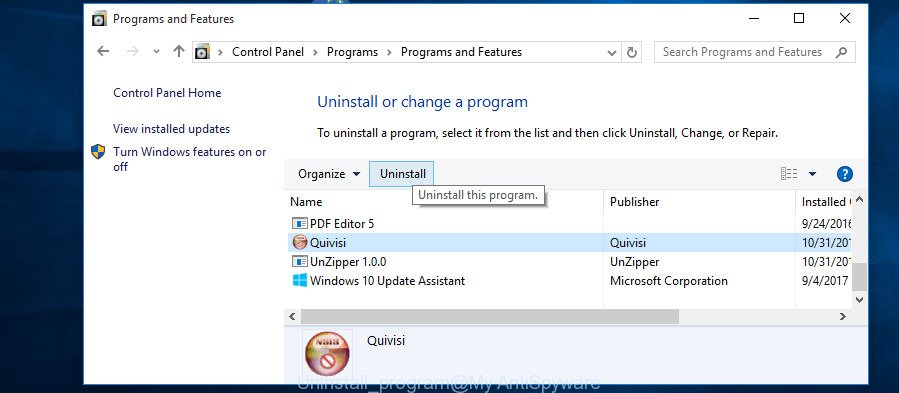
Look around the entire list of programs installed on your personal computer. Most likely, one of them is the ad-supported software that causes web browsers to display intrusive Whosopher.com popups. Choose the suspicious application or the program that name is not familiar to you and remove it.
Windows Vista, 7
From the “Start” menu in MS Windows, select “Control Panel”. Under the “Programs” icon, choose “Uninstall a program”.

Select the suspicious or any unknown software, then click “Uninstall/Change” button to uninstall this unwanted program from your system.
Windows XP
Click the “Start” button, select “Control Panel” option. Click on “Add/Remove Programs”.
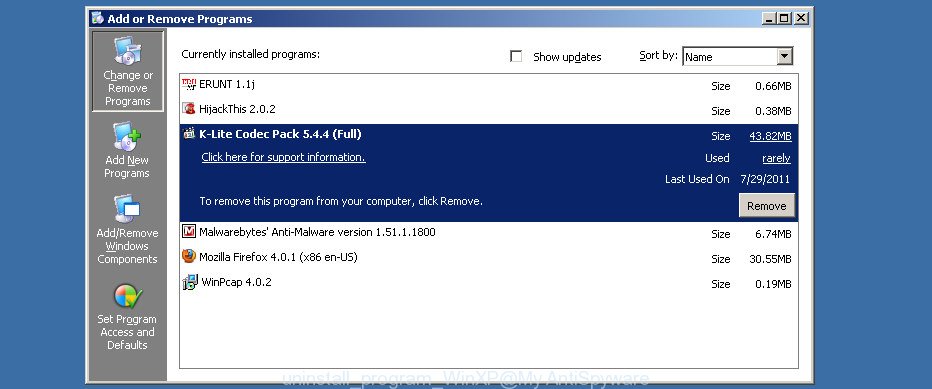
Select an undesired program, then click “Change/Remove” button. Follow the prompts.
Remove unwanted Scheduled Tasks
Once installed, the adware can add a task in to the Windows Task Scheduler Library. Due to this, every time when you boot your computer, it will display Whosopher.com unwanted web-site. So, you need to check the Task Scheduler Library and remove all malicious tasks which have been created by adware.
Press Windows and R keys on the keyboard at the same time. This displays a prompt that called Run. In the text field, type “taskschd.msc” (without the quotes) and click OK. Task Scheduler window opens. In the left-hand side, click “Task Scheduler Library”, as shown on the screen below.
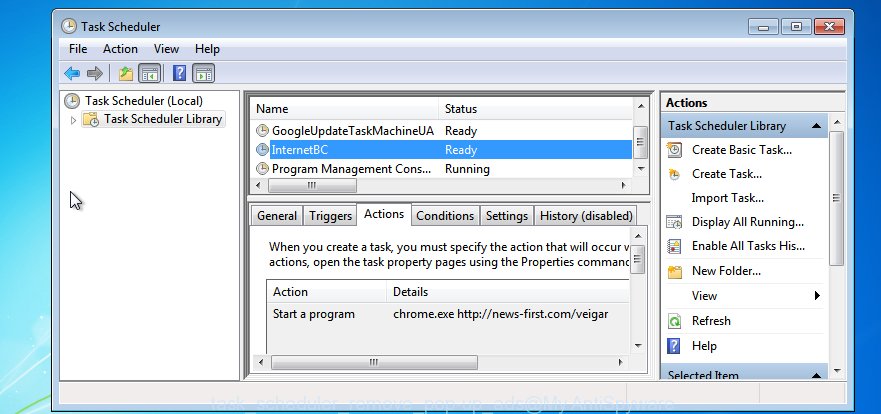
Task scheduler
In the middle part you will see a list of installed tasks. Please choose the first task, its properties will be open just below automatically. Next, press the Actions tab. Pay attention to that it launches on your computer. Found something like “explorer.exe http://site.address” or “chrome.exe http://site.address”, then get rid of this harmful task. If you are not sure that executes the task, check it through a search engine. If it is a component of the malicious programs, then this task also should be removed.
Having defined the task that you want to remove, then click on it with the right mouse button and select Delete as shown on the screen below.

Delete a task
Repeat this step, if you have found a few tasks that have been created by malicious software. Once is finished, close the Task Scheduler window.
Remove Whosopher.com from Mozilla Firefox by resetting web-browser settings
Resetting your FF is basic troubleshooting step for any issues with your web-browser program, including the redirect to Whosopher.com web-site.
First, run the FF and click ![]() button. It will display the drop-down menu on the right-part of the browser. Further, click the Help button (
button. It will display the drop-down menu on the right-part of the browser. Further, click the Help button (![]() ) as on the image below
) as on the image below
.

In the Help menu, select the “Troubleshooting Information” option. Another way to open the “Troubleshooting Information” screen – type “about:support” in the web-browser adress bar and press Enter. It will open the “Troubleshooting Information” page as on the image below. In the upper-right corner of this screen, click the “Refresh Firefox” button.

It will show the confirmation prompt. Further, press the “Refresh Firefox” button. The Firefox will start a procedure to fix your problems that caused by the ad supported software responsible for redirects to Whosopher.com. Once, it’s done, click the “Finish” button.
Remove Whosopher.com pop up from Chrome
Like other modern web-browsers, the Google Chrome has the ability to reset the settings to their default values and thereby recover the web browser’s settings such as start page, newtab page and search provider by default that have been modified by the ad supported software responsible for Whosopher.com popup.

- First run the Chrome and click Menu button (small button in the form of three dots).
- It will open the Google Chrome main menu. Select More Tools, then click Extensions.
- You’ll see the list of installed add-ons. If the list has the addon labeled with “Installed by enterprise policy” or “Installed by your administrator”, then complete the following steps: Remove Chrome extensions installed by enterprise policy.
- Now open the Chrome menu once again, click the “Settings” menu.
- You will see the Google Chrome’s settings page. Scroll down and click “Advanced” link.
- Scroll down again and press the “Reset” button.
- The Google Chrome will show the reset profile settings page as on the image above.
- Next click the “Reset” button.
- Once this process is done, your internet browser’s homepage, new tab page and default search provider will be restored to their original defaults.
- To learn more, read the blog post How to reset Chrome settings to default.
Get rid of Whosopher.com pop-ups from Internet Explorer
In order to restore all web browser homepage, newtab page and search engine by default you need to reset the Internet Explorer to the state, which was when the Microsoft Windows was installed on your machine.
First, launch the Microsoft Internet Explorer, click ![]() ) button. Next, click “Internet Options” as shown on the screen below.
) button. Next, click “Internet Options” as shown on the screen below.

In the “Internet Options” screen select the Advanced tab. Next, click Reset button. The Microsoft Internet Explorer will open the Reset Internet Explorer settings prompt. Select the “Delete personal settings” check box and press Reset button.

You will now need to reboot your computer for the changes to take effect. It will remove adware responsible for redirecting your web-browser to Whosopher.com web-page, disable malicious and ad-supported web browser’s extensions and restore the IE’s settings such as start page, newtab and search provider by default to default state.
Fix hijacked web-browsers shortcuts to get rid of Whosopher.com redirect
When the adware is started, it can also alter the web browser’s shortcut files, adding an argument such as “http://site.address” into the Target field. Due to this, every time you launch the internet browser, it will show an undesired web-page.
Right click on the shortcut of hijacked web-browser as displayed in the following example.
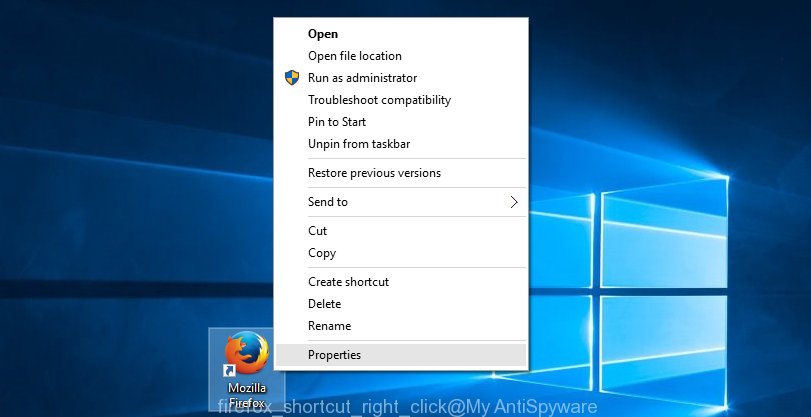
Select the “Properties” option and it’ll show the shortcut file’s properties. Next, press the “Shortcut” tab and then delete the “http://site.address” string from Target field like below.
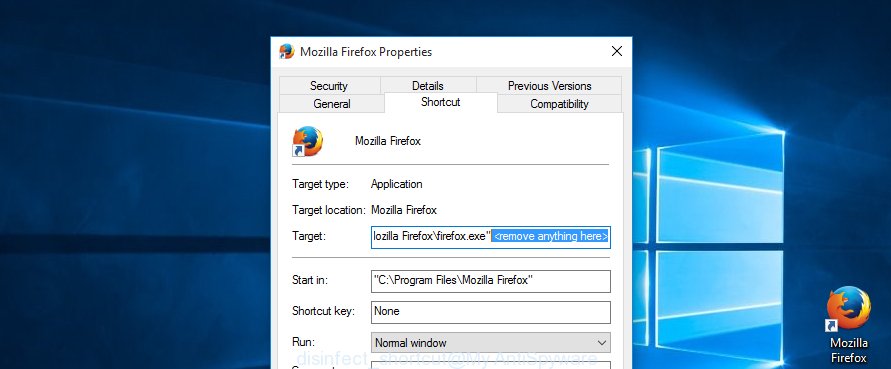
Then click OK to save changes. Repeat the step for all internet browsers which are redirected to the Whosopher.com intrusive web page.
Scan your system and get rid of Whosopher.com redirect with free tools
The adware may hide its components which are difficult for you to find out and remove completely. This may lead to the fact that after some time, the adware responsible for Whosopher.com popup once again infect your PC. Moreover, We want to note that it is not always safe to delete ad supported software manually, if you do not have much experience in setting up and configuring the Windows operating system. The best way to detect and delete ad-supported software is to use free malicious software removal software.
Scan and free your web browser of Whosopher.com redirect with Zemana Anti-malware
Zemana Anti-malware highly recommended, because it can search for security threats such adware and adwares that most ‘classic’ antivirus applications fail to pick up on. Moreover, if you have any Whosopher.com redirect removal problems which cannot be fixed by this tool automatically, then Zemana Anti-malware provides 24X7 online assistance from the highly experienced support staff.

- Download Zemana Anti Malware (ZAM) on your computer by clicking on the following link.
Zemana AntiMalware
164724 downloads
Author: Zemana Ltd
Category: Security tools
Update: July 16, 2019
- At the download page, click on the Download button. Your web-browser will show the “Save as” prompt. Please save it onto your Windows desktop.
- Once the downloading process is done, please close all applications and open windows on your PC system. Next, start a file called Zemana.AntiMalware.Setup.
- This will run the “Setup wizard” of Zemana AntiMalware (ZAM) onto your personal computer. Follow the prompts and do not make any changes to default settings.
- When the Setup wizard has finished installing, the Zemana Free will open and show the main window.
- Further, press the “Scan” button to look for ad supported software responsible for Whosopher.com redirect. This procedure can take some time, so please be patient. While the tool is scanning, you can see how many objects and files has already scanned.
- After the scan get completed, Zemana Free will open you the results.
- Review the results once the utility has done the system scan. If you think an entry should not be quarantined, then uncheck it. Otherwise, simply press the “Next” button. The tool will remove ad supported software that redirects your web-browser to intrusive Whosopher.com web-page. Once that process is complete, you may be prompted to restart the PC.
- Close the Zemana AntiMalware and continue with the next step.
Run Malwarebytes to remove Whosopher.com redirect
We recommend using the Malwarebytes Free which are completely clean your computer of the ad-supported software. The free utility is an advanced malware removal application made by (c) Malwarebytes lab. This program uses the world’s most popular anti malware technology. It’s able to help you remove intrusive Whosopher.com popup from your web browsers, PUPs, malware, hijackers, toolbars, ransomware and other security threats from your PC system for free.

Visit the page linked below to download MalwareBytes Anti-Malware. Save it directly to your Microsoft Windows Desktop.
326998 downloads
Author: Malwarebytes
Category: Security tools
Update: April 15, 2020
After the download is complete, run it and follow the prompts. Once installed, the MalwareBytes Free will try to update itself and when this procedure is complete, click the “Scan Now” button to scan for ad supported software that causes a huge number of unwanted Whosopher.com pop up. A scan can take anywhere from 10 to 30 minutes, depending on the number of files on your PC and the speed of your PC system. When a malware, adware or potentially unwanted applications are found, the count of the security threats will change accordingly. Wait until the the scanning is done. All found threats will be marked. You can get rid of them all by simply click “Quarantine Selected” button.
The MalwareBytes Anti-Malware (MBAM) is a free application that you can use to get rid of all detected folders, files, services, registry entries and so on. To learn more about this malware removal utility, we suggest you to read and follow the steps or the video guide below.
Remove Whosopher.com pop ups from internet browsers with AdwCleaner
AdwCleaner is a free removal tool that can be downloaded and run to get rid of adware responsible for Whosopher.com pop ups, browser hijackers, malicious software, potentially unwanted applications, toolbars and other threats from your machine. You can use this tool to search for threats even if you have an antivirus or any other security program.
Click the following link to download the latest version of AdwCleaner for MS Windows. Save it directly to your Microsoft Windows Desktop.
225509 downloads
Version: 8.4.1
Author: Xplode, MalwareBytes
Category: Security tools
Update: October 5, 2024
Download and use AdwCleaner on your machine. Once started, click “Scan” button to start checking your PC system for the ad supported software which cause unwanted Whosopher.com pop-ups to appear. This procedure may take some time, so please be patient. During the scan AdwCleaner will search for threats present on your PC system.. Once the system scan is done, the results are displayed in the scan report. Once you’ve selected what you want to remove from your system, click Clean button.
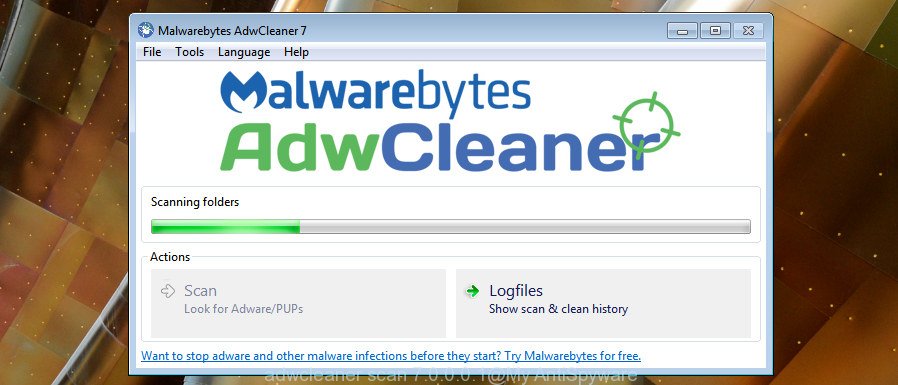
All-in-all, AdwCleaner is a fantastic free utility to clean your system from any undesired software. The AdwCleaner is portable program that meaning, you do not need to install it to run it. AdwCleaner is compatible with all versions of Microsoft Windows OS from MS Windows XP to Windows 10. Both 64-bit and 32-bit systems are supported.
How to block Whosopher.com pop ups
It is also critical to protect your internet browsers from harmful web sites and ads by using an ad-blocker application like AdGuard. Security experts says that it’ll greatly reduce the risk of malware, and potentially save lots of money. Additionally, the AdGuard can also protect your privacy by blocking almost all trackers.
- Download AdGuard program from the link below. Save it on your Windows desktop.Adguard download
26824 downloads
Version: 6.4
Author: © Adguard
Category: Security tools
Update: November 15, 2018
- When the downloading process is finished, start the downloaded file. You will see the “Setup Wizard” program window. Follow the prompts.
- Once the installation is finished, press “Skip” to close the setup program and use the default settings, or click “Get Started” to see an quick tutorial which will allow you get to know AdGuard better.
- In most cases, the default settings are enough and you don’t need to change anything. Each time, when you run your system, AdGuard will launch automatically and stop pop up, web-pages such Whosopher.com, as well as other malicious or misleading web-sites. For an overview of all the features of the program, or to change its settings you can simply double-click on the icon named AdGuard, which is located on your desktop.
How can you prevent your computer from the attack of Whosopher.com redirect
Many applications designed to open lots of unwanted ads within your machine’s browser. So, when you installing free software, carefully read the disclaimers, select the Custom or Advanced installation method to watch for bundled applications that are being installed, because certain of the software are potentially unwanted software like this ‘ad supported’ software that causes web-browsers to show undesired Whosopher.com pop-ups.
Finish words
Now your system should be free of the ad-supported software that causes a large amount of undesired Whosopher.com pop up. Remove AdwCleaner. We suggest that you keep AdGuard (to help you stop unwanted popup and annoying malicious web sites) and Zemana Anti Malware (to periodically scan your PC system for new adwares and other malicious software). Probably you are running an older version of Java or Adobe Flash Player. This can be a security risk, so download and install the latest version right now.
If you are still having problems while trying to get rid of Whosopher.com pop up from the Google Chrome, Firefox, Microsoft Internet Explorer and Edge, then ask for help in our Spyware/Malware removal forum.



















